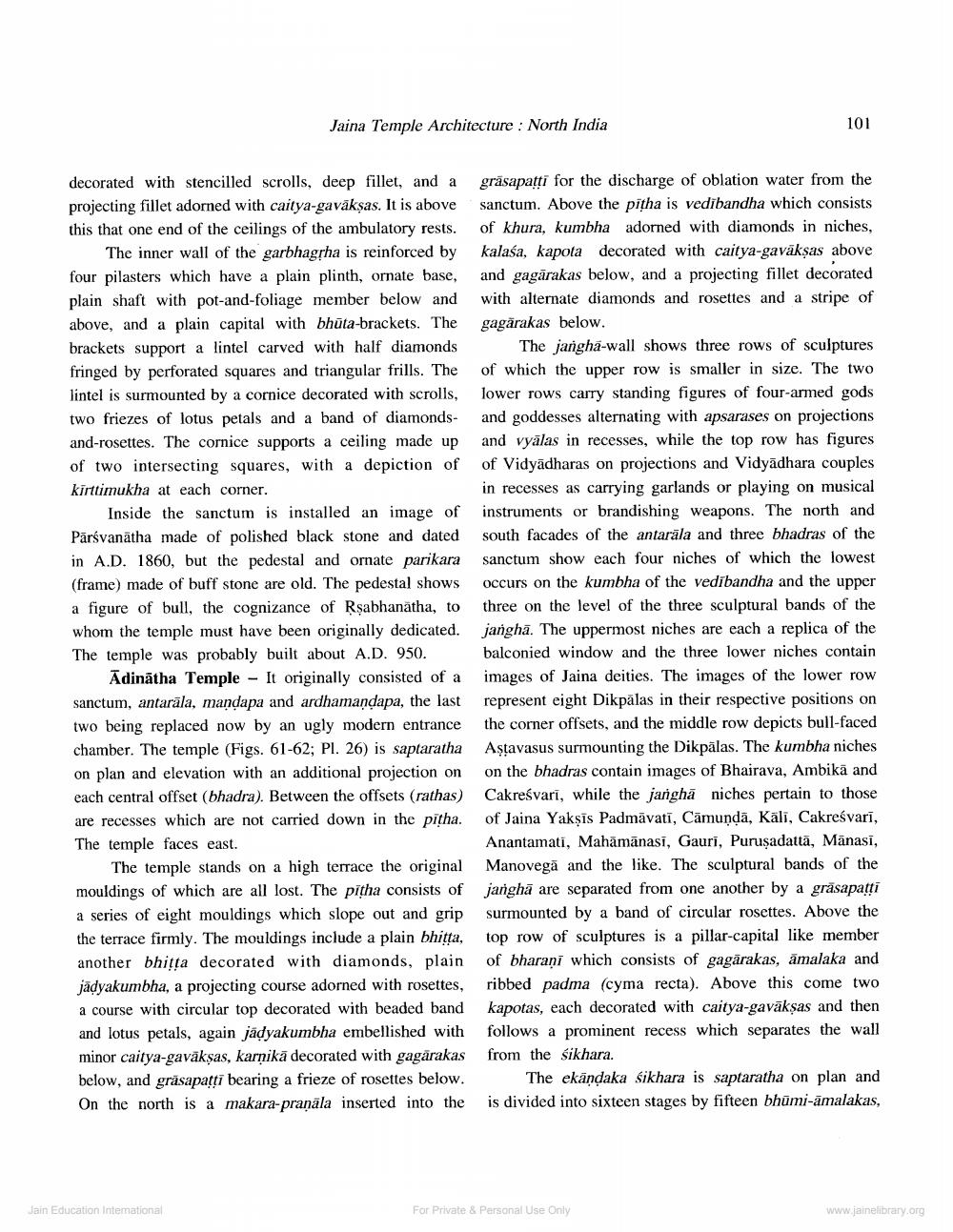________________
Jaina Temple Architecture : North India
101
decorated with stencilled scrolls, deep fillet, and a grāsapatti for the discharge of oblation water from the projecting fillet adorned with caitya-gavākşas. It is above sanctum. Above the pitha is vedībandha which consists this that one end of the ceilings of the ambulatory rests. of khura, kumbha adorned with diamonds in niches,
The inner wall of the garbhagrha is reinforced by kalasa, kapota decorated with caitya-gaväkşas above four pilasters which have a plain plinth, ornate base, and gagārakas below, and a projecting fillet decorated plain shaft with pot-and-foliage member below and with alternate diamonds and rosettes and a stripe of above, and a plain capital with bhūta-brackets. The gagărakas below. brackets support a lintel carved with half diamonds The jangha-wall shows three rows of sculptures fringed by perforated squares and triangular frills. The of which the upper row is smaller in size. The two lintel is surmounted by a cornice decorated with scrolls, lower rows carry standing figures of four-armed gods two friezes of lotus petals and a band of diamonds and goddesses alternating with apsarases on projections and-rosettes. The cornice supports a ceiling made up and vyālas in recesses, while the top row has figures of two intersecting squares, with a depiction of of Vidyādharas on projections and Vidyādhara couples kirttimukha at each corner.
in recesses as carrying garlands or playing on musical Inside the sanctum is installed an image of instruments or brandishing weapons. The north and Pārsvanatha made of polished black stone and dated south facades of the antarala and three bhadras of the in A.D. 1860, but the pedestal and ornate parikara sanctum show each four niches of which the lowest (frame) made of buff stone are old. The pedestal shows occurs on the kumbha of the vedībandha and the upper a figure of bull, the cognizance of Rşabhanatha, to three on the level of the three sculptural bands of the whom the temple must have been originally dedicated. janghā. The uppermost niches are each a replica of the The temple was probably built about A.D. 950. balconied window and the three lower niches contain
Adinātha Temple - It originally consisted of a images of Jaina deities. The images of the lower row sanctum, antarāla, mandapa and ardhamandapa, the last represent eight Dikpālas in their respective positions on two being replaced now by an ugly modern entrance the corner offsets, and the middle row depicts bull-faced chamber. The temple (Figs. 61-62; Pl. 26) is saptaratha Aştavasus surmounting the Dikpalas. The kumbha niches on plan and elevation with an additional projection on on the bhadras contain images of Bhairava. Ambika and each central offset (bhadra). Between the offsets (rathas) Cakreśvarī, while the janghā niches pertain to those are recesses which are not carried down in the pitha. of Jaina Yakşīs Padmăvati, Cāmunda, Kali, Cakreśvarī, The temple faces east.
Anantamati, Mahämānasi, Gauri, Purusadattā, Mānasi, The temple stands on a high terrace the original Manovegã and the like. The sculptural bands of the mouldings of which are all lost. The pitha consists of janghā are separated from one another by a grāsapatti a series of eight mouldings which slope out and grip surmounted by a band of circular rosettes. Above the the terrace firmly. The mouldings include a plain bhitta, top row of sculptures is a pillar-capital like member another bhitta decorated with diamonds, plain of bharani which consists of gagārakas, āmalaka and jadyakumbha, a projecting course adorned with rosettes, ribbed padma (cyma recta). Above this come two a course with circular top decorated with beaded band kapotas, each decorated with caitya-gavākşas and then and lotus petals, again jädyakumbha embellished with follows a prominent recess which separates the wall minor caitya-gavākṣas, karņikā decorated with gagärakas from the sikhara. below, and gräsapatti bearing a frieze of rosettes below. The ekāndaka śikhara is saptaratha on plan and On the north is a makara-pranāla inserted into the is divided into sixteen stages by fifteen bhūmi-āmalakas,
Jain Education Intemational
For Private & Personal Use Only
For Private & Personal Use Only
www.jainelibrary.org




